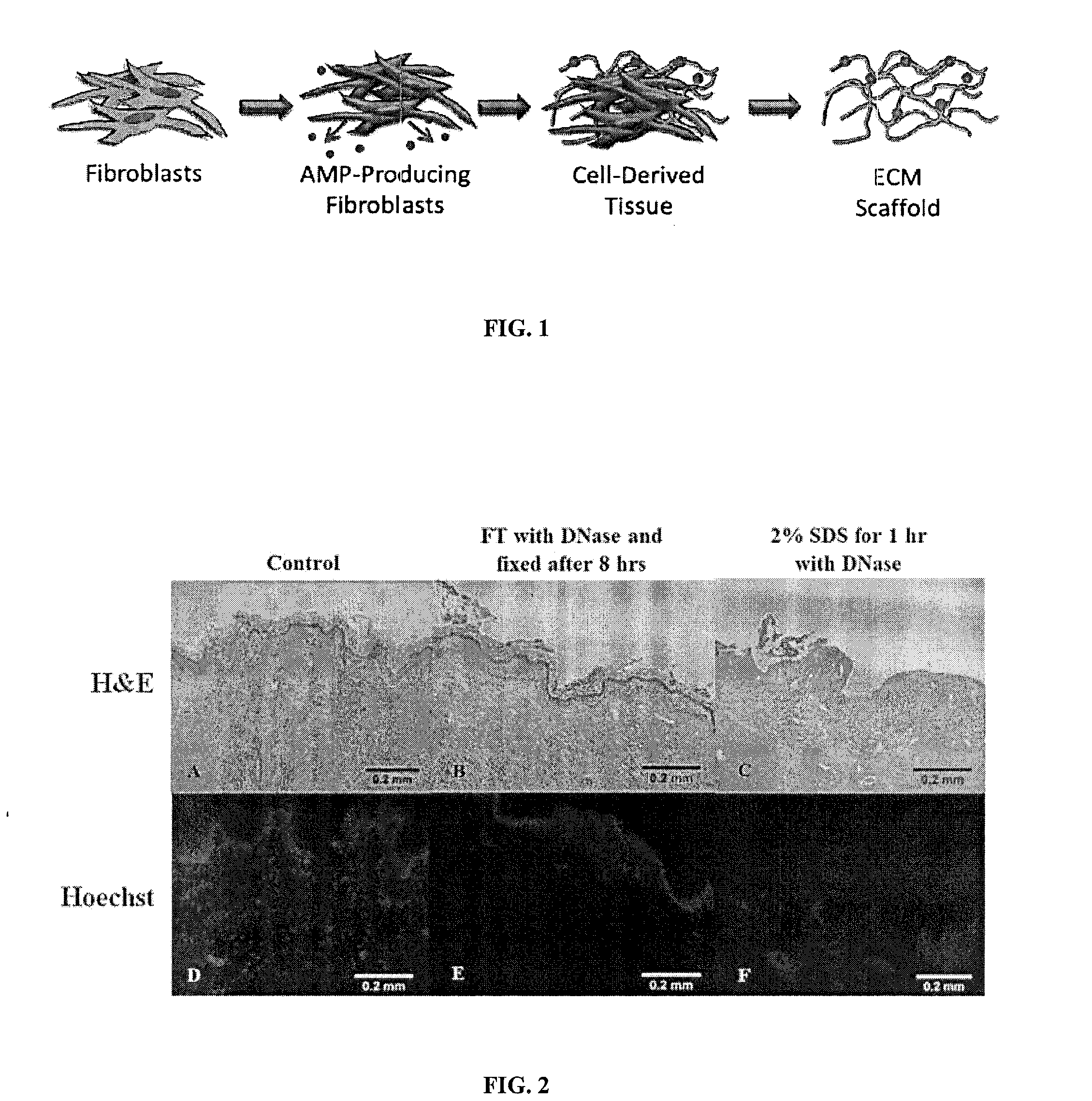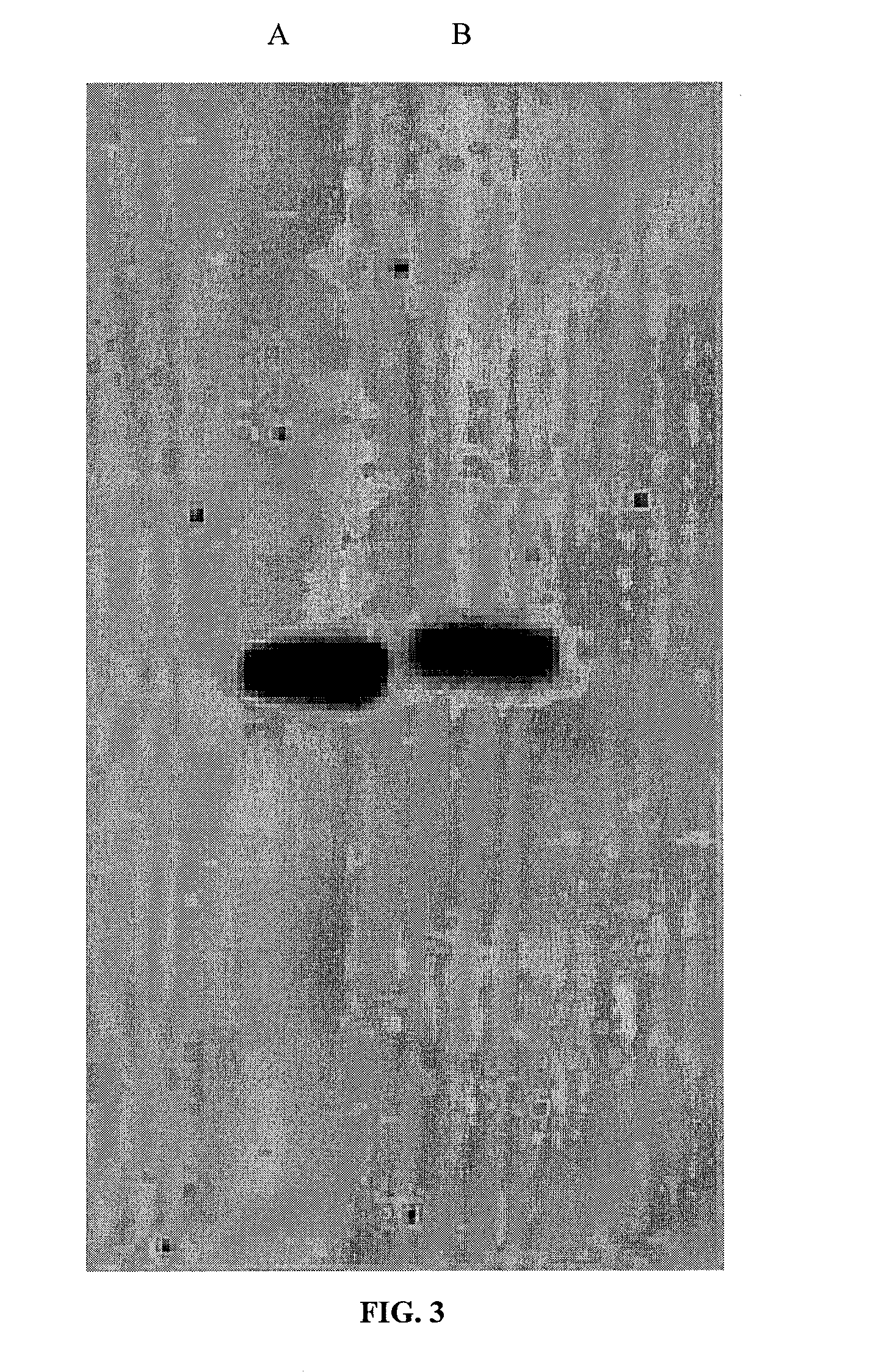Matrix scaffold with antimicrobial activity
- Summary
- Abstract
- Description
- Claims
- Application Information
AI Technical Summary
Benefits of technology
Problems solved by technology
Method used
Image
Examples
example 1
A. Decellularization of Foreskins
[0050]Decellularization protocols were tested on foreskin samples as model demial tissue (foreskins collected from UMass Memorial University Hospital with IRB approval). Samples were prepared by scraping off fatty tissue and cutting the dermis to the size of 0.5 cm×0.25 cm.
[0051]1) Freeze-Thaw: Four samples were decellularized according to the protocol reported by Ngangan and McDevitt, 2009 (Biomaterials, 30(6):1143-49). The samples were immersed in liquid nitrogen for 2 min and then rotated in PBS at room temperature (RT) for 5 min. This cycle was repeated 3 times. Two of these samples were treated with DNase (1 mg / mL,
[0052]10 mM MgCl2) for 15 min following all freeze-thaw (FT) cycles. One was fixed immediately after treatment, and one was fixed 8 hours after treatment.
[0053]2) Sodium Dodecyl Sulfate: Six samples were decellularized using sodium dodecyl sulfate (SDS) according to the protocol by Elder et al., 2009 (Biomaterials, 30(...
example 2
Chimeric Peptide Production
[0064]The 510 bp cathelicidin insert was isolated and amplified from pANT7 cGST (DNASU Plasmid Repository, Clone ID HsCD00357894, GenBank Acc. No. 570277) using PCR. Primers were designed to include and incorporate the recombinant features onto the cathelicidin insert. One forward and two reverse primers (corresponding to each CBD) were ordered from Integrated DNA Technologies (IDT). The sequences of the three primers are shown in FIG. 6.
[0065]For PCR, the samples were prepared by combining 10 μL of Promega's GoTac Green Mastermix, 1 μL of the template (pANT7-cGST), 1 μl forward primer, 1 μL reverse primer, and ddH2O to 20 μL. PCR controls included a sample with no primers, and two with primers and no template (the two corresponding to each of the reverse primers). The PCR thermocycler (Bio-Rad, MyCycler) was set to 4 min at 90° C. (30 s at 95° C., 30 s at 55° C., 1 min at 72° C)×30, 4 min at 72° C., and ∞ at 10° C. Agarose gel electrophoresis, pre-stained...
example 3
Localization of Chimeric Peptide
[0089]Transformation of E. coli and Verification Cathelicidin Construct. The pGEM vector with the recombinant cathelicidin DNA insert was amplified by E. coli transformation. Transformations were carried out with 50 μL of chemically competent E. coli and 2 μL of the pGEM plasmid with DNA insert in a cold Eppendorf tube. This mixture was incubated on ice for 20 minutes, heat shocked at 42° C. in a water bath for 45 s, before it was returned to ice for another 2 minutes. The E. coli received 450 μL of prewarmed LB media and was incubated at 37° C. under shaking at 100 rpm for one hour. 50 μL of the transformed E. coli were plated on to Pre-warmed LB agar Ampicillin plates. These plates were incubated overnight at 37° C.
[0090]The following day individual colonies were selected and inoculated in 3 mL of LB with 100 μg / mL of Ampicillin media and incubated overnight at 37° C. with shaking at 190 rpm. Macherey and Nagel's Nucleospin plasmid purification prot...
PUM
| Property | Measurement | Unit |
|---|---|---|
| Antimicrobial properties | aaaaa | aaaaa |
Abstract
Description
Claims
Application Information
 Login to View More
Login to View More - R&D
- Intellectual Property
- Life Sciences
- Materials
- Tech Scout
- Unparalleled Data Quality
- Higher Quality Content
- 60% Fewer Hallucinations
Browse by: Latest US Patents, China's latest patents, Technical Efficacy Thesaurus, Application Domain, Technology Topic, Popular Technical Reports.
© 2025 PatSnap. All rights reserved.Legal|Privacy policy|Modern Slavery Act Transparency Statement|Sitemap|About US| Contact US: help@patsnap.com



